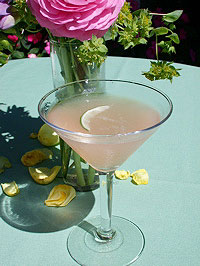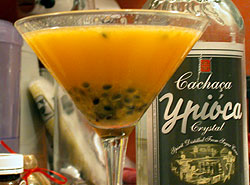Sidecar
I have René Engel to thank for getting me to like these, back in the late ’90s.
I learned a bit more about this drink during Chad Solomon and Christy Pope’s brandy seminar in Los Angeles in 2007, sponsored by Hennessy Cognac, during the part where they were tracing the development of cocktails in Europe.
While the cocktail can be called America’s first great contribution to the culinary arts, the Europeans finally started to catch up in the early 20th Century. One classic that emerged from that period, and is perhaps the best-known brandy cocktail today, despite its relative obscurity with the general drinking public, is the Sidecar, which emerged around the end of World War I. As with many cocktails there are myriad stories as to its origin; Harry MacElhone, in his classic work Harry’s ABC of Mixing Cocktails, cites a bartender from London by the name of Pat MacGarry. David Embury, author of The Fine Art of Mixing Drinks, gives credit to an American officer in Paris who asked a bartender for a kind of brandy sour and named it after the side car of his motorcycle. Whoever did it … well, thanks. We like it.
And whoever did it … it’s not an entirely original concept, having descended from the Crusta, and being in a category of drinks Gary Regan calls “New Orleans Sours;” i.e., spirit, orange liqueur, citrus. The original proportion, as it was made in France during its beginnings, were equal proportions of brandy, triple sec and lemon juice. Perhaps it’s just that tastes have changed, but in this proportion I place this into a category of drinks I call “Not Very Good.” Not bad, just undistinguished. Try a small one, with 1/2 ounce of each ingredient — I suspect you’ll agree.
Later on the proportions evolved to 2 parts brandy and 1 each of triple sec and lemon juice, which some people still favor but others find too tart. Try it and see what you think.
For a while I started making them in the “classic” proportion of 4:2:1 (which is incidentally a good starting-off point if you’re trying to create a new drink with spirit, liqueur and citrus; you can vary from there as you need, and add seasoning via dashes of this and that). That’d be 2 ounces Cognac, 1 Cointreau and 1/2 lemon. Still a good drink.
However, Christy and Chad, as well as several of the other bartenders present, favor a 3:2:1 proportion, which oddly enough is the proportion I’d been using for my Margaritas but not my Sidecars. I will now. It was goo-ooo-ood.
Sidecar
1-1/2 ounces Cognac.
1 ounce Cointreau.
1/2 ounce fresh lemon juice.Combine with cracked ice in a cocktail shaker and shake for
no less than 10-12 seconds. Strain into a sugar-rimmed
cocktail glass.
Gaz Regan is quick to point out that you will have to adjust the proportion and balance of the ingredients depending on which Cognac you use; Courvoisier does not give you the same Sidecar as Hennessy does! Experiment! It’s fun!
I’m not a huge fan of the traditional sugar rim either, so a good compromise to satisfy every guest is to sugar only half the rim. Don’t ever use one of those sponge-dipper glass rimmers, either. To rim a glass with sugar (or salt for Margaritas) rub a cut piece of lemon on the outside of the glass and dredge the moistened exterior rim of the glass in a saucer of bar sugar.







